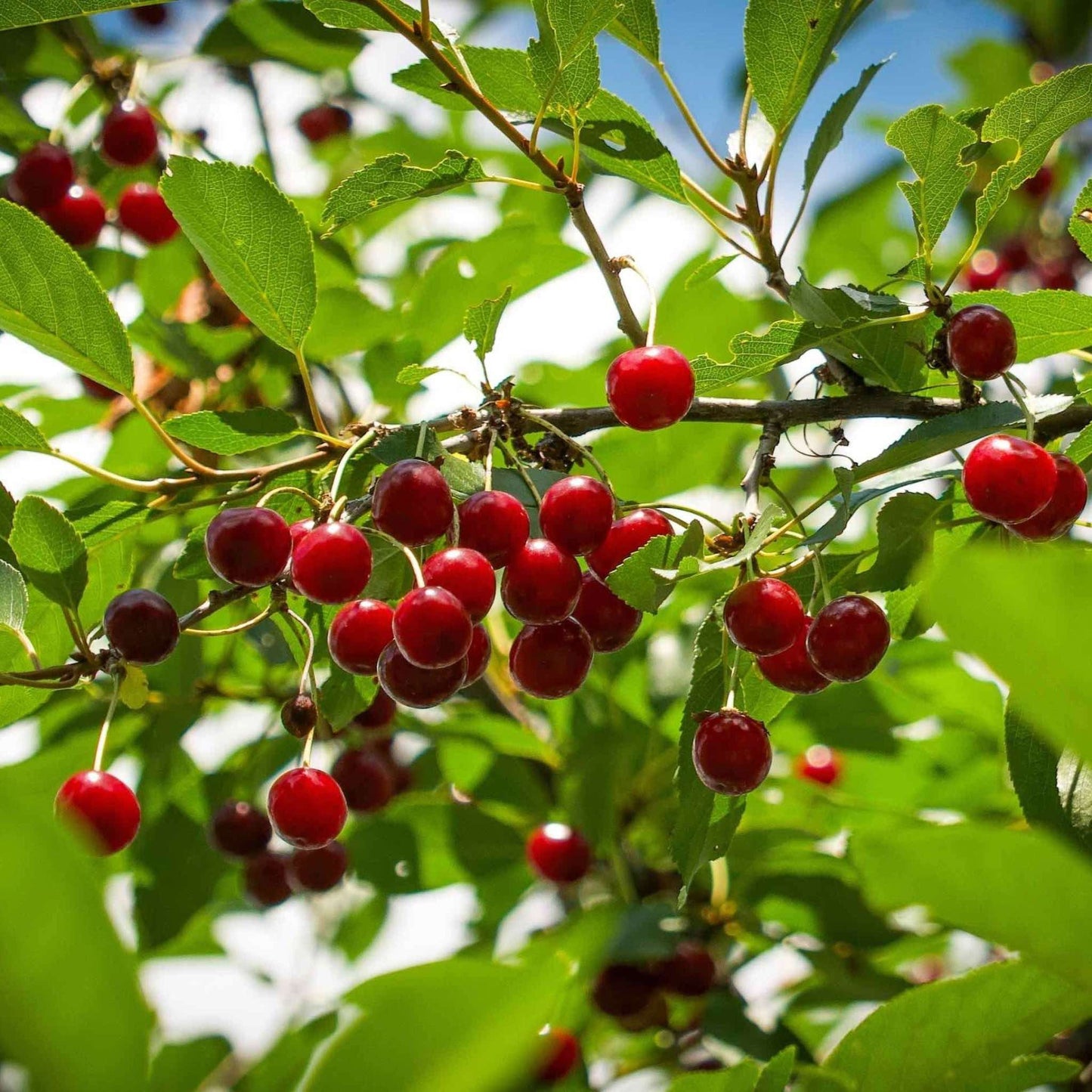Romeo and Juliet Cherry Trees
Romeo and Juliet Cherry Trees
SKU:EDB-CHE-RNJ-NA-3G
Romeo and Juliet Cherry Trees: Enjoy Twice the Flavor
Why settle for one cherry tree when you can have two? Our Romeo and Juliet Cherry Trees provide abundant harvests and sweet, robust flavor, all while staying compact. You’ll love their versatility, snacking and baking potential, and impressive cold hardiness.
Please note: These two trees will arrive in the same pot, but we recommend separating them and planting them in-ground near each other for pollination. While these varieties are self-pollinating, planting them near each other should increase fruit production.
Why You'll Love the Romeo Cherry Tree
- Manageable Size: Ideal for smaller yards or containers, growing just 6-8 feet tall.
- Heavy Harvest: Despite its size, Romeo produces a generous crop of juicy cherries in summer.
- Cold-Hardy: This tough tree can withstand harsh winters, making it perfect for colder climates.
Why You'll Love the Juliet Cherry Tree
- Compact Size: Grows only about 7 feet tall, perfect for small spaces or container growing.
- Sweet, Rich Flavor: These bright, sweet-sour cherries are great for fresh eating, baking, or preserving.
- Easy Care: Low maintenance with high fruit yield—perfect for beginners!
Harvest Your Own Sweet Cherries
Enjoy twice the harvests with the Romeo and Juliet Cherry Trees! Their manageable size means you can plant them just about anywhere, and their delicious flavor means you can whip all sorts of jams, desserts, and snacks.
Harvesting fresh cherries from home is rewarding and fun. Don’t wait to start growing yours!



Product Details
-
Product Category
Edibles
-
Product Subcategory:
Cherry Trees
-
Botanical Name:
Prunus x kerrasis Romeo, Prunus x kerrasis Juliet
-
Does Not Ship To:
AZ, CA, ID, WA, OR
-
Mature Height:
5-8 ft.
-
Mature Width:
5-7 ft.
-
Growing Zone:
2-7 outdoors
-
Indoor Growing:
-
Sunlight:
Full Sun
-
Growth Rate:
Moderate
-
Harvest Time:
Summer
-
Bloom Time:
Spring

Planting Directions
<h2>How to Plant and Care for Romeo and Juliet Cherry Trees</h2> <h3>Planting Instructions</h3> <ul> <li><strong>Location:</strong> Choose a spot with full sun (6+ hours) and well-draining soil. These trees are cold-hardy and do best in USDA zones 2-7.</li> <li><strong>Soil:</strong> Prefer slightly acidic to neutral soil (pH 6.0-7.0). Amend with compost if needed.</li> <li><strong>Planting Time:</strong> Spring or early fall is best for planting to give roots time to establish before harsh weather.</li> <li><strong>Hole Depth:</strong> Dig a hole twice the width of the root ball and just as deep. The root flare (where the trunk widens) should be at soil level.</li> <li><strong>Spacing:</strong> Allow 8-10 feet of space from other trees or structures to provide room for growth.</li> <li><strong>Planting:</strong> Place the tree in the hole, backfill with soil, and water well to remove air pockets. Mulch around the base (but not touching the trunk) to retain moisture.</li> </ul> <h3>Watering Instructions</h3> <ul> <li><strong>Initial Watering:</strong> Water deeply after planting, ensuring moisture reaches the root zone.</li> <li><strong>Ongoing:</strong> Water 1-2 times per week during the first year, depending on rainfall, ensuring the soil is moist but not waterlogged.</li> <li><strong>Mulching:</strong> Mulch helps retain moisture and regulate soil temperature.</li> </ul> <h3>Fertilizing</h3> <ul> <li>Apply a balanced fertilizer (10-10-10) in early spring before new growth appears.</li> <li>Do not over-fertilize, as this can reduce fruiting.</li> </ul> <h3>Pruning</h3> <ul> <li>Prune in late winter or early spring to remove dead or diseased branches and shape the tree.</li> </ul> <h3>Pollination</h3> <p>These trees are self-pollinating, but planting them near each other will help to increase fruit production.</p>

FAQs
<h2>FAQs for Romeo and Juliet Cherry Trees</h2> <h3>1. How big do these trees get?</h3> <p>The Romeo and Juliet Cherry Trees are compact varieties, reaching about 5 to 8 feet tall and 5-7 feet wide at maturity. They're perfect for small gardens, and because of their size, they're easy to maintain and harvest without needing a ladder.</p> <h3>2. Can these trees be grown in containers?</h3> <p>Although these trees are best suited in-ground, planted near each other, you can grow them in large containers when they're young, especially in urban gardens or patios. As long as they have enough sunlight and well-draining soil, they will produce cherries in pots. Container-grown trees may need a bit more attention to watering since pots dry out faster.</p> <h3>3. Do the Romeo and Juliet Cherry Trees need a pollinator to produce fruit?</h3> <p>No, these trees are both self-pollinating. However, planting them near each other will drastically help to increase fruit production.</p> <h3>4. When can I expect to harvest cherries from my Romeo and Juliet Cherry Trees?</h3> <p>The Romeo and Juliet Cherry Trees typically produce fruit in mid to late summer. Once planted, you can expect your first harvests in about 2-3 years, with yields increasing each year. The cherries are sweet, tart, and perfect for pies or preserves!</p> <h3>5. How much sunlight do the Romeo and Juliet Cherry Trees need?</h3> <p>These cherry trees love sunlight! Make sure they get at least 6 hours of direct sunlight each day to ensure healthy growth and optimal fruit production. If grown in partial shade, the fruit yield may decrease.</p>




